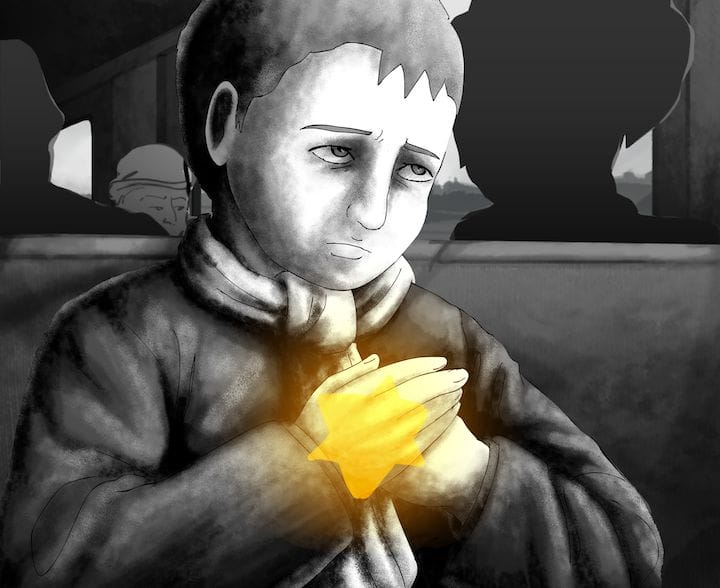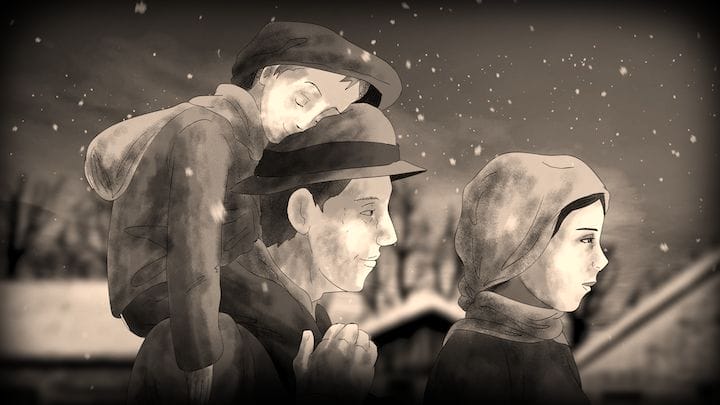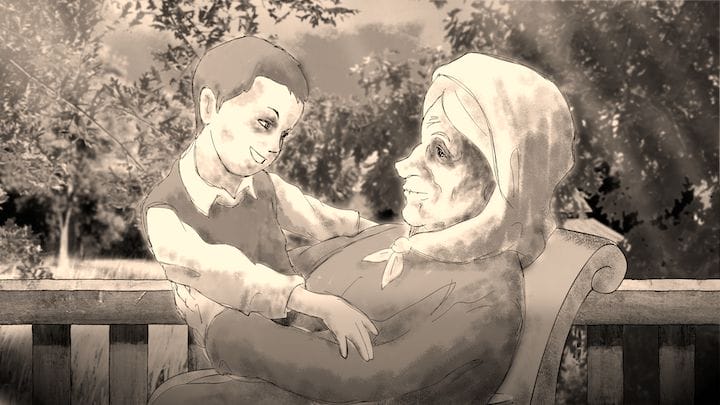SPONSORED CONTENT
![]() A Powerful Story of Justice, Memory, and Moral Courage
A Powerful Story of Justice, Memory, and Moral Courage
By Victoria Talbot, The Jewish World

The Berkshire International Film Festival (BIFF) returns this spring to Great Barrington, MA, bringing an array of compelling films from across the globe. One of the most anticipated titles on this year’s lineup is “Among Neighbors” the gripping new documentary feature by award-winning Jewish filmmaker Yoav Potash.
Scheduled for Friday, May 30 at 11:45 AM at Triplex Cinema #3, “Among Neighbors” is already earning critical acclaim on the international film circuit. Known for his hard-hitting documentaries such as “Crime After Crime” and “Food Stamped,” Potash now turns to a striking blend of animation and documentary storytelling with the same passion for truth, social justice, and emotional depth that defines his work.






![]()
About the Film: ‘Among Neighbors’
Set in Gniewoszów, a small town in rural Poland where its Jewish population was decimated by the Holocaust, “Among Neighbors” unravels a tapestry of interconnected lives, layered with secrets, generational trauma, and the quiet strength of those who bear witness. The story centers in part on Pelagia Radecka, a woman who, decades after witnessing the postwar murder of Holocaust survivors in the town, breaks her silence in search of the boy she once loved. As she comes forward, the ripple effects uncover tensions, histories, and moments of unexpected compassion across cultures, faiths, and generations.
 CLICK on these words TO SEE THE TRAILER
CLICK on these words TO SEE THE TRAILER
The film deftly weaves together animated scenes narrated by Pelagia Radecka and its other leading subject, Yaacov Goldstein, who is one of the last living Holocaust survivors from the town. The result delivers a profound emotional realism found in the best documentaries, offering audiences a haunting but ultimately hopeful meditation on truth, silence, and moral courage.
 Filming eyewitnesses in Gniewoszów
Filming eyewitnesses in Gniewoszów
Accolades include:
- Winner: Audience Award, Best Documentary Feature, San Francisco Independent Film Festival
- Winner: Envision Award, Jewish Film Institute
- Winner: Special Award, Warsaw Jewish Film Festival
- Winner: Best Documentary, Los Angeles Film Awards
- Official Selections: Santa Barbara International Film Festival, Phoenix Film Festival, Independent Film Festival Boston, and others
- Praise from The Jerusalem Post: “A fascinating new documentary”
Q&A with Director Yoav Potash 
The Jewish World asked Yoav Potash to discuss the inspiration behind the film, his filmmaking philosophy, and the impact he hopes “Among Neighbors” will have on audiences and communities around the world.
What originally drew you to the story of “Among Neighbors”? Was there a specific moment or issue that made you say, “This needs to be a film”?
The saga of making this film began back in 2014, when my friend and colleague Anita Friedman invited me to visit Poland in order to film the rededication of the Jewish cemetery in what was once her father’s hometown. To give that ceremony some context, I began filming interviews with the town’s oldest residents and asking them about the prewar era, in which well over half the town’s population was Jewish. During filming, a few of the elderly townsfolk admitted that Holocaust survivors were murdered in the town, six months after Nazi Germany surrendered and World War II was over. This tragedy – and the fact that I had found a few living eyewitnesses willing to speak of it from their perspective as non-Jewish Poles – was like a bombshell for me, and it motivated me to transform this from a small side project to a serious film.

Much of your past work, like “Crime After Crime,” focuses on social justice. How does “Among Neighbors” continue or expand that mission for you as a filmmaker?
I am most interested in bringing untold stories to light, especially when there has been irreparable harm or a miscarriage of justice that most people – if they are made aware of the facts – would want corrected or addressed in whatever way possible. So in “Crime After Crime,” the miscarriage of justice was that a victim of horrible physical and sexual abuse was sentenced to life in prison for the murder of her abuser (and this was a murder in which she was essentially no more than an unwitting accomplice to the actual killers). And in “Among Neighbors,” it’s a case of irreparable harm; the fact that Holocaust survivors were murdered not only in the little town featured in the film, but in cities and towns across Poland and much of Eastern Europe. This bloodshed effectively extended the Holocaust for another year or more, and signalled that any significant regrouping and continuation of Jewish life in Poland would be impossible.

Gniewoszów today

This film delves deeply into the dynamics of Jewish and non-Jewish communities living side by side in prewar Poland. How did you approach representing these perspectives authentically, especially across cultures and faiths?
It was crucial for me, as a Jewish filmmaker, to allow Polish non-Jews to tell their side of the story in their own words. I was fortunate to find a handful of elders who were willing to not only warmly recall the relatively peaceful coexistence of Jews and non-Jewish Poles before the war, but to also describe the violent antisemitism that ultimately ended Jewish life in their town. Foremost among these eyewitnesses was Pelagia, who had a deep, heartfelt connection with her Jewish neighbors and who gave searing testimony about the murders. We brought her story to life with hand-drawn animation, and I worked with a team of wonderful Polish animators to do that, further ensuring that her story was told in a way that would honestly reflect Polish history and culture.

Jewish values like tikkun olam (repairing the world) and chesed (kindness) seem woven into the fabric of the film. How did your Jewish identity inform your direction and narrative choices?
My identity as a Jewish-American certainly was part of what prompted me to tumble down the rabbit hole of this story in the first place. Growing up as a Jewish kid in sunny southern California, I got little tastes of the lost world of Jewish life in Eastern Europe whenever my grandmother used a Yiddish phrase, or when I would look at artwork in our home that depicted “the Old Country,” or even when my parents took me to see the play “Fiddler on the Roof.”
So I was always curious about this way of life and why it no longer existed. Of course I also learned about the Holocaust – probably at too young of an age, considering that the history lessons given over at Hebrew school prompted my first nightmares as a child – and for most of my life I did not give much thought to what happened in Eastern European towns in the immediate aftermath of World War II. We were told that most of the few surviving Jews emigrated to America or Israel or perhaps somewhere else, and that was that. Only after I first visited Poland in 2014 did I consider the fact that most Holocaust survivors would of course first return to their hometowns to at least try to see who and what survived. The fact that such a journey resulted in their murder in hundreds of instances during a time when the Nazis were gone was deeply troubling, not only to me as a Jew, but as a human being.

Two Polish men return a stolen Hebrew tombstone to the Jewish cemetery
To then help audiences comprehend and feel that tragedy, I worked to depict the full range of the Jewish/Polish dynamic, including the fact that Jews and non-Jews had thrived together in Poland for centuries. Giving viewers a sense of the hundreds of years of Jewish life in Poland makes the abrupt and violent end to that era of symbiosis all the more tragic and affecting.
What challenges did you face in balancing realism with hope? The film doesn’t shy away from pain, but it also leaves space for healing and connection.
Both Yaacov and Pelagia conveyed their own sense of hope, even as they told stories of incredible tragedy and trauma. Yaacov, for example, used the word “miracle” to describe multiple events in his story, expressing gratitude for those moments despite the fact that the painful periods of his young life could have easily crushed every hopeful and optimistic fiber in most people.
For example, Yaacov was hidden for almost two years in a cramped hiding place where he was treated like an animal in a cage. While this experience and others left Yaacov with psychological and emotional scars, he could still recognize and even laugh about the miracles he experienced, as well as about others that he still hoped would come one day. Meanwhile, Pelagia’s primary motivation for telling her story now was that she hoped that by doing so, she might find Janek Weinberg, the son of the murder victims who she heard had survived the killings. So while Yaacov was able to look at his traumatic past and nonetheless see miracles in it, Pelagia was speaking up about her trauma in hope of finding a miracle in the present.
So it was important to leave space in the film for healing and connection because the two individuals who are at the heart of the film found a way to seek that healing themselves. In addition, the fact that both of these individuals maintained hope against overwhelming odds gave the film an important emotional counterbalance against the immeasurable loss of the Holocaust and its aftermath. Or to say it another way, even someone who thinks “I just cannot watch Holocaust movies, it’s just too awful,” can watch this film and be inspired by these two people.
Was there a particular character or storyline in the film that affected you most personally during filming or editing?
Both Pelagia and Yaacov deeply affected me and my whole team of editors, animators, and film crew, as well as Anita Friedman, who became the film’s Executive Producer. We all were brought to tears by these two individuals, and I am especially grateful to Anita for supporting my vision for this film as it evolved with each new discovery.
At first, in 2014, we were simply trying to tell the story of this town’s Jewish cemetery and why all aspects of Jewish life in the town – from the Jewish people to the Jewish tombstones – seemed to have vanished without a trace. The testimony of local elders soon led me to investigate the town’s dark secret: the postwar murders, so that was the first transformation of this project. Then, a year after filming began, Pelagia Radecka emerged and her account added tremendous depth and emotion to the film, and inspired me to add animation to bring her story to life. Finally, in 2018, I found Yaacov Goldstein, one of the last living Holocaust survivors from this little town. His harrowing survival story was jaw-dropping – and crucial to include – but weaving in his story meant that the film would need to be taken apart and then put back together again, adding years before it could be completed. Throughout all this, Anita supported and trusted my instincts as a filmmaker, and I am beyond grateful to her for that.
You’re known for immersive, documentary-style storytelling. How did your background influence the way you directed animation to create dramatic scenes within “Among Neighbors”?
Much of the power of documentary film lies in the fact that these are real people and real events, so it was crucial that any animation we add to the film would only accentuate that foundation of authenticity. So that guiding principle motivated me to select a realistic style of hand-drawn, black and white animation that could work well with the archival footage of the period, and to maintain the narration of our interviewees even as we watch animated scenes depicting their experiences.
At the same time, to keep things interesting and dynamic for the viewer, it’s usually better not to show your audience the exact same thing that you are already telling them because it will make the overall cinematic experience feel a bit dry and predictable, like a narrated slideshow rather than a film. So this motivated me to add touches of magical realism to the animation, allowing us to not only show viewers what the past looked like, but also what it felt like for our main characters. So for example, when Yaacov describes how he could be killed for attempting to blend in as a non-Jew in Nazi-occupied Poland, the animated child version of Yaacov looks down to discover that the yellow star he’s recently torn from his clothing is still there, now beating inside his chest like a heart.
The film invites audiences into difficult conversations—about antisemitism, trauma, faith, and belonging. What kind of dialogue are you hoping it sparks within Jewish and other communities?
We’re hoping this film can spark much-needed conversations about antisemitism, which of course has ramped up tremendously in recent years, as well as the other universal topics you mentioned. The film imparts valuable historical context to all viewers, whether they are a World War II buff or a middle school student with little knowledge of what happened during the Holocaust. The film also brings these historical issues all the way to today, in part through the subplot of how the Polish government recently attempted to outlaw any account of Polish culpability in the Holocaust. The film also presents scenes and themes that are truly universal. On a human level, the film is telling stories of people struggling to overcome and recover from intense trauma. At perhaps more than one point in the film, such hope appears foolish or impossible, and yet by the end of the film we’ve also witnessed miracles that I think can inspire anyone facing adversity, whether in a communal or a personal way, and whether in a Jewish context or not.
You’ve worked on projects that blend art and activism. How do you see “Among Neighbors” functioning as both a cinematic experience and a catalyst for social change?
Throughout the decade that it took to make this film, my focus was on making this a powerful and emotional cinematic experience. Now that the film is complete, I recognize that it can and should be used to combat antisemitism, to spark important conversations around trauma, faith, and belonging, and to help all of us grapple with even the most painful aspects of our national and personal histories.
How do you hope “Among Neighbors” will be used or remembered? Are there future screenings, educational partnerships, or expansions in the works?
We are planning a theatrical release in movie theaters from coast to coast beginning in October of this year. I will be participating in filmmaker Q&A’s in every major city where the film is released, and our distribution team will work with local partner organizations, such as film festivals (both Jewish and general festivals), synagogues, Holocaust organizations, museums, and community centers. In some cases, the film screening events will include a panel discussion with local leaders, such as elected officials, rabbis, academics, and Jewish influencers. I’m proud to add here that we have recently entered into a partnership with the USC Shoah Foundation to support the film’s release and the education campaign to accompany it. Anyone representing an organization that is interested in participating or bringing their community to one of our screening events should contact us through our website, amongneighbors.com.
About the Director: Yoav Potash
Yoav Potash is an award-winning filmmaker, writer, and social justice advocate. He garnered national attention with the Sundance-premiered “Crime After Crime,” which later aired on the Oprah Winfrey Network (OWN) and earned 20 honors, including both the Audience Award and the Best Documentary Award at the Berkshire International Film Festival in 2011. His other previous documentary feature, “Food Stamped,” earned the Jury Prize at the San Francisco Independent Film Festival and was used nationwide in policy discussions to spotlight food insecurity. A graduate of UC Berkeley, he lives in the San Francisco Bay Area with his family, and continues to use storytelling as a bridge toward understanding and change.
Screening Details — Berkshire International Film Festival
- Film: “Among Neighbors”
- Director: Yoav Potash
- Date & Time: Friday, May 30 at 11:45 AM
- Location: Triplex Cinema #3, Great Barrington, MA
- Festival: Berkshire International Film Festival (BIFF)
Tickets: Now available at the BIFF website
Trailer: Watch online now and prepare to be moved
Whether you’re a longtime admirer of Potash’s work or discovering his filmmaking for the first time, “Among Neighbors” promises to be a deeply resonant and unforgettable experience. Don’t miss your chance to engage with a story that challenges, heals, and ultimately unites.









